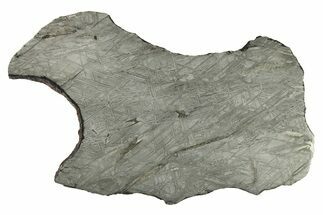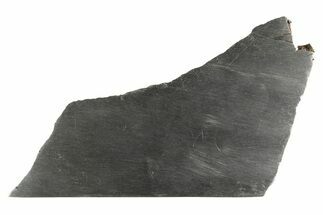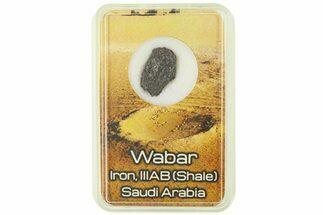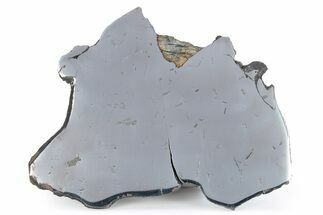This Specimen has been sold.
.7" Abai Iron Meteorite (5.2 g) - Kazakhstan
This is a .7" wide (5.2 gram) section o the Abai iron meteorite. The 666-gram mass was found during a survey of the cultural alyers at first-century ruins named Altyn-Kazgan, near the Aral Sea in southwestern Kazakhstan. No other specimens were found with or near it, so researchers believe the meteorite was brought to that location by residents sometime around the first century.
This specimen has been polished to a mirror finish on its cut side, while the natural sides display the lovely fusion crust. A beautiful piece to add to anyone's collection! This specmien comes in an acrylic display case.
This specimen has been polished to a mirror finish on its cut side, while the natural sides display the lovely fusion crust. A beautiful piece to add to anyone's collection! This specmien comes in an acrylic display case.
About Iron Meteorites
Iron type meteorites are composed primarily of iron and nickel, and are the remnants of differential cores torn apart at the beginning of the solar system. These metallic meteorites are often the easiest to identify after millions of years post-impact because they are quite different from terrestrial material, especially when it comes to their mass-to-surface area ratio. They are exceptionally heavy for their size since iron is a high-density metal: this is also why the Earth's core is nickel-iron. As planets form, the densest metals form gravitational centers, bringing more and more material into their gravitational pull. In the solar system's rocky planets, these dense materials are most often nickel and iron.
Most iron meteorites have distinctive, geometric patterns called Widmanstätten patterns, which become visible when the meteorite is cut and acid etched. These patterns are criss-crossing bands of the iron-nickel alloys kamacite and taenite that slowly crystalized as the core of the meteorites' parent bodies slowly cooled. Such large alloy crystallizations for mover millions of years and do not occur naturally on Earth, further proving that iron meteorites come from extraterrestrial bodies.
Iron type meteorites are composed primarily of iron and nickel, and are the remnants of differential cores torn apart at the beginning of the solar system. These metallic meteorites are often the easiest to identify after millions of years post-impact because they are quite different from terrestrial material, especially when it comes to their mass-to-surface area ratio. They are exceptionally heavy for their size since iron is a high-density metal: this is also why the Earth's core is nickel-iron. As planets form, the densest metals form gravitational centers, bringing more and more material into their gravitational pull. In the solar system's rocky planets, these dense materials are most often nickel and iron.
Most iron meteorites have distinctive, geometric patterns called Widmanstätten patterns, which become visible when the meteorite is cut and acid etched. These patterns are criss-crossing bands of the iron-nickel alloys kamacite and taenite that slowly crystalized as the core of the meteorites' parent bodies slowly cooled. Such large alloy crystallizations for mover millions of years and do not occur naturally on Earth, further proving that iron meteorites come from extraterrestrial bodies.
TYPE
Iron, IIIAB
LOCATION
Southern Kazakhstan
SIZE
.7 x .45 x .3", Weight: 5.2 grams
CATEGORY
ITEM
#265991
 Reviews
Reviews













